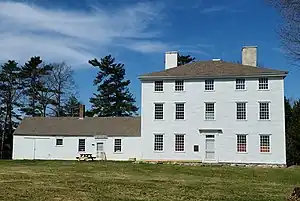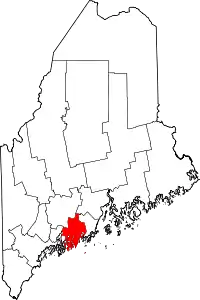Dresden, Maine
Dresden is a town in Lincoln County, Maine, United States, that was incorporated in 1794. The population was 1,725 at the 2020 census.[2]
Dresden, Maine | |
|---|---|
 | |
 Location in Lincoln County and the state of Maine. | |
| Coordinates: 44°6′25.14″N 69°43′26.29″W | |
| Country | United States |
| State | Maine |
| County | Lincoln |
| Incorporated | 1794 |
| Area | |
| • Total | 33.21 sq mi (86.01 km2) |
| • Land | 30.45 sq mi (78.87 km2) |
| • Water | 2.76 sq mi (7.15 km2) |
| Elevation | 210 ft (64 m) |
| Population (2020) | |
| • Total | 1,725 |
| • Density | 57/sq mi (21.9/km2) |
| Time zone | UTC-5 (Eastern (EST)) |
| • Summer (DST) | UTC-4 (EDT) |
| ZIP code | 04342 |
| Area code | 207 |
| FIPS code | 23-18475 |
| GNIS feature ID | 0582446 |
| Website | www |
History
The town was originally settled in 1752 under the name Frankfort by French and German Huguenots, who were part of the first wave of French-speaking immigrants to arrive in Maine, but were distinguished from later arrivals by their Protestant faith. William Shirley built Fort Shirley in the community at the same time Fort Halifax (Maine) was built. The town was incorporated as Pownalborough in 1760, when Lincoln County was created in the Maine District of Massachusetts.[3] Pownalborough included the Town of Wiscasset, which was soon set off on its own as the shire town of the county. When the present territory was incorporated in 1794, Lincoln County Probate Judge Jonathan Bowman chose Dresden as the new name of the town because he liked the sound of it.[4]
Dresden is located on the eastern side of the Kennebec River.[5] Historic sites include an old, brick school building and the Pownalborough Courthouse, which is now used as a museum and is open to the public. The Pownalborough Courthouse was built in 1760 and was the first seat of government east of the Kennebec River. The families who settled Dresden and those who were soon afterward sent there by the government of Massachusetts played a crucial role in the battle for American independence in Maine. Robert Treat Paine, John Hancock, and John Adams appeared at the Court House in the Revolutionary Era. Well known local families included the Goodwins, Houdlettes, Mayerses, Bridges, Bowmans, Percys, Johnsons, and Trussells, who variously left their marks on the history of the town, the state, and the country.[6]
Geography
According to the United States Census Bureau, the town has a total area of 33.21 square miles (86.01 km2), of which 30.45 square miles (78.87 km2) is land and 2.76 square miles (7.15 km2) is water.[1] Dresden is drained by the Kennebec River and the Eastern River, which merges into the former at the southern tip of Green Point and the southeastern side of Swan Island. The Eastern River has long been a favored spot to fish for smelt in shacks centered above holes made in the winter ice.
Dresden's other notable geographical features are Blinn Hill and The Great Bog. At 440 feet (134 m) above sea level, Blinn Hill affords a view of the White Mountains, more than 100 miles (160 km) away. The Great Bog is primeval and lies not far from the natural foot of Blinn Hill.
Demographics
| Census | Pop. | Note | %± |
|---|---|---|---|
| 1800 | 700 | — | |
| 1810 | 1,096 | 56.6% | |
| 1820 | 1,338 | 22.1% | |
| 1830 | 1,559 | 16.5% | |
| 1840 | 1,647 | 5.6% | |
| 1850 | 1,419 | −13.8% | |
| 1860 | 1,247 | −12.1% | |
| 1870 | 990 | −20.6% | |
| 1880 | 1,032 | 4.2% | |
| 1890 | 1,043 | 1.1% | |
| 1900 | 882 | −15.4% | |
| 1910 | 815 | −7.6% | |
| 1920 | 620 | −23.9% | |
| 1930 | 629 | 1.5% | |
| 1940 | 631 | 0.3% | |
| 1950 | 729 | 15.5% | |
| 1960 | 766 | 5.1% | |
| 1970 | 787 | 2.7% | |
| 1980 | 998 | 26.8% | |
| 1990 | 1,332 | 33.5% | |
| 2000 | 1,625 | 22.0% | |
| 2010 | 1,672 | 2.9% | |
| 2020 | 1,725 | 3.2% | |
| U.S. Decennial Census[7] | |||
2010 census
As of the census[8] of 2010, there were 1,672 people, 700 households, and 482 families residing in the town. The population density was 54.9 inhabitants per square mile (21.2/km2). There were 819 housing units at an average density of 26.9 per square mile (10.4/km2). The racial makeup of the town was 98.6% White, 0.2% African American, 0.1% Native American, 0.3% Asian, 0.2% from other races, and 0.7% from two or more races. Hispanic or Latino of any race were 1.3% of the population.
There were 700 households, of which 29.0% had children under the age of 18 living with them, 55.9% were married couples living together, 7.4% had a female householder with no husband present, 5.6% had a male householder with no wife present, and 31.1% were non-families. 23.7% of all households were made up of individuals, and 9% had someone living alone who was 65 years of age or older. The average household size was 2.39 and the average family size was 2.78.
The median age in the town was 45 years. 20.5% of residents were under the age of 18; 6.8% were between the ages of 18 and 24; 22.6% were from 25 to 44; 36.3% were from 45 to 64; and 13.7% were 65 years of age or older. The gender makeup of the town was 51.3% male and 48.7% female.
2000 census
As of the census[9] of 2000, there were 1,625 people, 642 households, and 455 families residing in the town. The population density was 53.0 inhabitants per square mile (20.5/km2). There were 739 housing units at an average density of 24.1 per square mile (9.3/km2). The racial makeup of the town was 97.42% White, 0.25% African American, 0.25% Native American, 0.49% Asian, and 1.60% from two or more races. Hispanic or Latino of any race were 0.12% of the population.
There were 642 households, out of which 34.1% had children under the age of 18 living with them, 57.0% were married couples living together, 7.6% had a female householder with no husband present, and 29.1% were non-families. 20.2% of all households were made up of individuals, and 8.6% had someone living alone who was 65 years of age or older. The average household size was 2.53 and the average family size was 2.92.
In the town, the population was spread out, with 25.9% under the age of 18, 5.5% from 18 to 24, 32.3% from 25 to 44, 24.5% from 45 to 64, and 11.8% who were 65 years of age or older. The median age was 37 years. For every 100 females, there were 104.1 males. For every 100 females age 18 and over, there were 101.0 males.
The median income for a household in the town was $41,719, and the median income for a family was $44,762. Males had a median income of $31,488 versus $20,750 for females. The per capita income for the town was $18,886. About 9.5% of families and 12.5% of the population were below the poverty line, including 19.5% of those under age 18 and 10.3% of those age 65 or over.
Site of interest
Education
Dresden is part of the Kennebec Intra-District Schools Regional School Unit.
For the 2011 to 2012 school year, there were approximately 104 students in Dresden Elementary School.[10]
Notable people
- David Kidder, US congressman
- Jeffrey Pierce, state legislator
- Lewis Turco, poet, teacher and writer
References
- "US Gazetteer files 2010". United States Census Bureau. Retrieved December 16, 2012.
- "Census - Geography Profile: Dresden town, Lincoln County, Maine". Retrieved January 19, 2022.
- Coolidge, Austin J.; John B. Mansfield (1859). A History and Description of New England. Boston, Massachusetts: A.J. Coolidge. p. 110.
coolidge mansfield history description new england 1859.
- Varney, George J. (1886), Gazetteer of the state of Maine. Dresden, Boston: Russell
- Maine League of Historical Societies and Museums (1970). Doris A. Isaacson (ed.). Maine: A Guide 'Down East'. Rockland, Me: Courier-Gazette, Inc. pp. 255–256.
- Charles E. Allen (1931). History of Dresden, Maine. Lewiston, Me.
- "Census of Population and Housing". Census.gov. Retrieved June 4, 2015.
- "U.S. Census website". United States Census Bureau. Retrieved December 16, 2012.
- "U.S. Census website". United States Census Bureau. Retrieved January 31, 2008.
- "Kids RSU2 School District". Halldale.org. Retrieved May 6, 2012.
